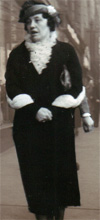
Family Rivers: the Women
I like thinking of family history as the confluence of rivers. I don't want to be a little twig poking out on the edge of an aging oak tree. I want to be the Mississippi, collecting my family's lives into my own.
 As of this week I have photos of all my great grandparents, so I felt compelled
to lay them out and have a look.
As of this week I have photos of all my great grandparents, so I felt compelled
to lay them out and have a look.
I have to say that what strikes me first is the power of women.
Sarah Newham left home early to live with her brother in Derbyshire (England), where she met the carpenter Bill Price. They emigrated to America, had 6 sons and opened a carpentry business. My dad said she was the brains of the business. After she died in 1927, things got less organized. The Great Depression didn't help, but neither did the drinking among Bill and his sons.
It was her daughter-in-law Bridget Dunne Price who stepped up and intervened. About 1936 she yanked my grandfather Walter from his father's shop, took out another mortgage on the house, bought a truck and put him in business with his brother Tab.
Bridget must have gotten her no-nonsense business head from her mother. Catherine Martin Dunne, who raised nine children on a quasi-communal farm in Galway, then figured out how to lay her hands on another piece of property a few miles away. She moved herself there, where she ran a second farm and contributed substantially to the family's prosperity.
On the other side of the family, Maggie Keville Flanagan died too young to do much other than give birth to 7 children, but it is her absence we sense in pondering the ill fate of most of her children as her husband Moses struggled to keep the family afloat. It was her second daughter — Kitty Flanagan Barrett Curran, my grandmother — who rose above it all with tremendous resiliency, intelligence and ambition.
 When her
husband died in 1926, leaving her with 4 young children and two grocery
stores, Kitty had two roles models to draw wisdom from. First, she had seen her father put his two youngest daughters in an orphanage
and fail at recruiting another wife and mother for his kids.
When her
husband died in 1926, leaving her with 4 young children and two grocery
stores, Kitty had two roles models to draw wisdom from. First, she had seen her father put his two youngest daughters in an orphanage
and fail at recruiting another wife and mother for his kids.
On the other hand, Kitty's mother-in-law Ellen Gibbons Barrett was definitely a strong-minded woman, who browbeat her husband Frank into leaving the family farm in Catawissa, Missouri, because she couldn't stand being under the domination of his mother. But within a few years of their moving to St Louis, Frank died. Ellen wasn't fortunate enough to own a business to support her four children. She compelled her oldest son — my grandfather Tom Barrett — and his brother Francis to drop out of high school and carry the family burden.
Our Kitty would have nothing to do with either path. She'd seen enough of family dissolution. And she'd seen the bitterness of her husband for having to assume family obligations too young. She had a business and she made it work. She eventually was able to hand the grocery store over to her boys and for a while she ran a bar and grill to give work to her oldest daughter. And she made sure her baby — my mother Kathleen, the reluctant scholar — finished high school.
Luckily Kathleen landed a man — Bridget's son and Sarah's grandson — who understood that women were supposed to have the brains and the power so that the men could be free to love their children and find the fullness of life while sharing its burdens.
7.4.07
My diagram is assymetrical to include both of Kitty Flanagan's husbands — my mother's biological father Tom Barrett and the father of her heart Ewald Curran. Families are not always about biology.
Great Grandparents
Moses Flanagan
Maggie Keville
Frank Barrett
Ellen Gibbons
Michael Dunne
Catherine Martin
Bill Price
Sarah Newham
Grandparents
Ewald Curran
Kitty Flanagan
Tom Barrett
Bridget Dunne
Walter Price
Parents
Kathleen Barrett
Walter Price
Us
Tom Price
Ellen Price
Susan Price
Kathleen Price
PHOTO Below: Catherine "Kitty" Flanagan Barrett Curran, 1930s or 1940s.
